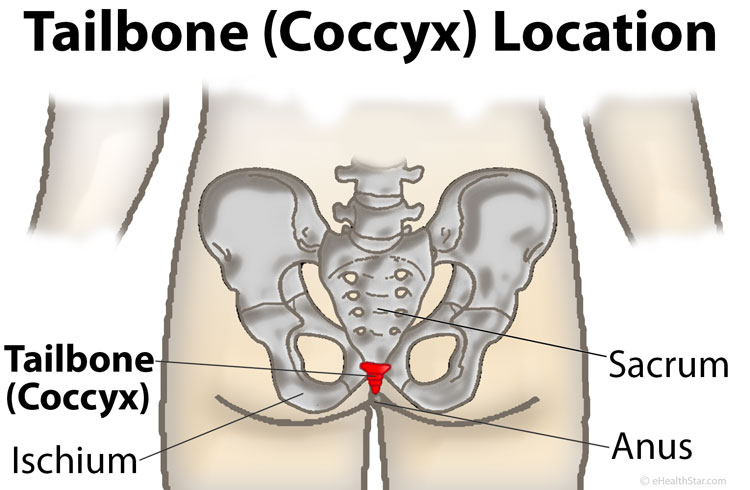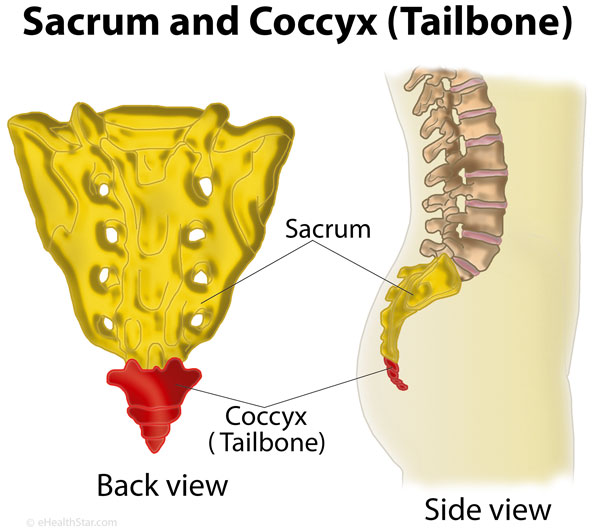What is coccyx (tailbone) and where is it located?
Coccyx (tailbone) is the lowest part of the spinal column. It extends down from the sacrum between the buttocks and ends about an inch (2.5 cm) above the anus [12-p.329]. At this site, coccyx pain appears.
Picture 1. Coccyx location
Human coccyx consists of 3-5 separate or fused bony parts (vertebrae), most commonly of 4 [2,3,14]. The average coccyx length is 1.8 inch (4.5 cm) but can vary a lot and is often greater in men [3].
Coccyx has got its name from its resemblance to cuckoo beak (in Greek cuckoo = kokkux) [1]. The anatomical name for coccyx is os coccyx.
Coccyx pronunciation: koksiks [1].
“Coccygeal” means pertaining to coccyx, for example, coccygeal ligament.
Coccyx Anatomy Diagram
Picture 2. Sacrum and coccyx diagram
The lower end of the coccyx is bent forward, so its anterior surface is concave and its posterior surface is convex. The tip (apex) of the coccyx is rounded.
Coccyx Function
Coccyx assists in weight-bearing when a person is seated, especially when leaning backward [2].
The anterior coccygeal surface serves as the attachment for the anterior sacrococcygeal ligament and the muscles of the pelvic floor (levatores ani) that support parts of the rectum and, in women, urethra and vagina.
The borders of the coccyx give attachments on either side to the sacrotuberous and sacrospinous ligaments, to the coccygeus muscle in front of the ligaments, and to the gluteus maximus muscle behind them.
Coccygeal Joints
The joints between the tailbone segments can be true (synovial) joints, they can contain thin cartilaginous discs as in most other parts of the spine or can be fused (ossified) as in the sacrum [7,9].
The coccyx makes a joint with the sacrum via the sacrococcygeal junction [2].
Coccygeal Ligaments
The anterior, posterior and lateral sacrococcygeal ligaments attach the sacrum to the coccyx [2].
The sacrospinous ligament, which connects the sacrum with the spine of the ischium (the lower part of the hip bone), is also attached to the coccyx [2].
The sacrotuberous ligament, which connects the sacrum and the tuberosity of the ischium, is also attached to the coccyx [2].
The anococcygeal ligament or raphe is in the middle of the part of the levator ani muscle that attaches the anus and the coccyx.
Coccygeal Muscles
Muscles attached to the ANTERIOR coccyx surface:
Levator ani, which consists of iliococcygeus, pubococcygeus and coccygeus muscle [11]
- Origin: Pubic bone and the ischium of the hip bone
- Insertion: Anterior surface of the coccyx
- Innervation: 3rd, 4th and 5th sacral nerve, perineal nerve or pudendal nerve [5,8]
- Functions:
- Forms the “pelvic floor,” which supports the pelvic organs from sagging; it also supports the urethra and prostate
- It constricts the lower end of the rectum and thus helps in maintaining bowel continence; it also elevates the rectum during the bowel movement and thus assists in bowel emptying [8]
- It constricts the lower end of the vagina [8]
Muscles attached to the POSTERIOR coccyx surface:
Gluteus maximus [4]
- Origin: Posterior surface of the sacrum and coccyx
- Insertion: gluteal tuberosity of the femur
- Function: extends backward and rotates laterally the thigh in hip, abducts (extends laterally) the thigh
Muscles attached to the TIP of the coccyx:
External anal sphincter, which surrounds the outer part of the anus [5].
- Function: Maintains the anus closed
- Innervation: Pudendal plexus [6]
Nerves in the Coccygeal Area
The 5th sacral nerves (the right and left root) leave the spinal canal between the sacrum and coccyx [6].
The coccygeal nerves (the right and left root) arise below the 5th sacral nerve and run around the upper part of the coccyx [6].
The 5th sacral and coccygeal nerve supply the posterior part of the levator ani muscle and the external anal sphincter [6]. They also form the coccygeal plexus, which gives rise the sensory anococcygeal nerves, which enable sensitivity of the skin in the coccyx area above the anus [10].
The pudendal plexus is formed by the 2nd to 5th sacral nerve and the coccygeal nerve [6]. It gives anococcygeal and pudendal nerve, visceral and muscular branches.
Coccyx Deformities
- Not centered (misaligned)
- Not curved, straight
- Excessively curved, crooked
- Angled (L-shaped, hooked)
- Curved sideways (scoliosis)
- Extended
- Protruding, making a hard bump above the anus
- Bifurcated
- Missing (in caudal regression syndrome) [13]
- References
- Coccyx definition and pronunciation Dictionary.com
- Coccyx pain Emedicine
- Woon JT et al, 2013, CT morphology and morphometry of the normal adult coccyx PubMed Central
- Gluteus maximus muscle GetBodySmart
- The rectum and anal canal Darmouth College
- Grey H, Anatomy of the Human Body, 1918, The Sacral and Coccygeal Nerves Bartleby.com
- Maigne JY, 2002, Management of common coccygodynia Coccyx.org
- Grey H, Anatomy of the Human Body, 1918, The Muscles and Fasciæ of the Pelvis Bartleby.com
- Postacchini F et al, 1983, Idiopathic coccygodynia. Analysis of fifty-one operative cases and a radiographic study of the normal coccyx PubMed
- Woon JT et al, 2014, Redefining the coccygeal plexus PubMed
- Kearney R et al, 2004, Levator Ani Muscle Anatomy Evaluated by Origin-Insertion Pairs PubMed Central
- Snell RS, 2012, Clinical Anatomy by Regions, 9th Edition
- Caudal regression syndrome Rare Diseases
- Grey H, Anatomy of the Human Body, 1918, The sacral and coccygeal vertebrae Bartleby.com




I have pain across the top of my buttocks. Bending over is very painful; walking without my cane is very painful; lifting a jug of of water is very painful; standing longer than 2 minutes is painful; and when I stand, I stand like a pregnant woman. In June of this year, I fell twice. The second fall, I broke the faucet off. I was badly bruised from my left shoulder to half way acros and st stomachs the back, and from the left shoulder all the way down my butt and across the entire butt. My butt and and stomach are quite swollen; so swollen that I went up one whole panty size. CAN YOU HELP ME?Is there a special doctor I should seeI would like a response as soon as possible!
why is it my thaighs and calfs are paining even if I am seating whole day in office in the chair,very rarely riding on motarcycle and lifting any heavy or seating on the floor
Sudhir, I can’t quite imagine where your pain is, but one possible cause of pain in the legs due to prolonged sitting is a pinched nerve in the lumbar spine – the condition is known as “sciatica.”
Hello, my name is Renee and I am a Certified Wound Ostomy Continence nurse. I am developing education for a hospital in regards to pressure ulcer staging and prevention. I like the pictures on this website http://www.ehealthstar.com/anatomy/coccyx-tailbone
Could I have permission to utilize these photos in my presentation slides?
Thank you, Renee CWOCN
Renee, you can use the images, if you mention the source. If you intend to use images online, please provide a live link to the article.